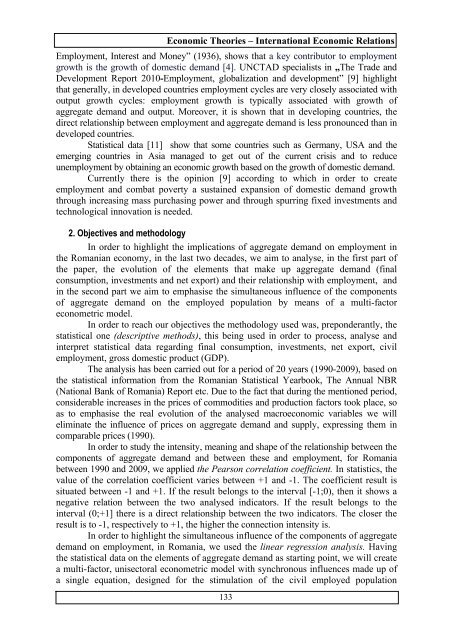Revista Tinerilor Economiºti (The Young Economists Journal)
Revista Tinerilor Economiºti (The Young Economists Journal)
Revista Tinerilor Economiºti (The Young Economists Journal)
Create successful ePaper yourself
Turn your PDF publications into a flip-book with our unique Google optimized e-Paper software.
Economic <strong>The</strong>ories – International Economic Relations<br />
Employment, Interest and Money” (1936), shows that a key contributor to employment<br />
growth is the growth of domestic demand [4]. UNCTAD specialists in „<strong>The</strong> Trade and<br />
Development Report 2010-Employment, globalization and development” [9] highlight<br />
that generally, in developed countries employment cycles are very closely associated with<br />
output growth cycles: employment growth is typically associated with growth of<br />
aggregate demand and output. Moreover, it is shown that in developing countries, the<br />
direct relationship between employment and aggregate demand is less pronounced than in<br />
developed countries.<br />
Statistical data [11] show that some countries such as Germany, USA and the<br />
emerging countries in Asia managed to get out of the current crisis and to reduce<br />
unemployment by obtaining an economic growth based on the growth of domestic demand.<br />
Currently there is the opinion [9] according to which in order to create<br />
employment and combat poverty a sustained expansion of domestic demand growth<br />
through increasing mass purchasing power and through spurring fixed investments and<br />
technological innovation is needed.<br />
2. Objectives and methodology<br />
In order to highlight the implications of aggregate demand on employment in<br />
the Romanian economy, in the last two decades, we aim to analyse, in the first part of<br />
the paper, the evolution of the elements that make up aggregate demand (final<br />
consumption, investments and net export) and their relationship with employment, and<br />
in the second part we aim to emphasise the simultaneous influence of the components<br />
of aggregate demand on the employed population by means of a multi-factor<br />
econometric model.<br />
In order to reach our objectives the methodology used was, preponderantly, the<br />
statistical one (descriptive methods), this being used in order to process, analyse and<br />
interpret statistical data regarding final consumption, investments, net export, civil<br />
employment, gross domestic product (GDP).<br />
<strong>The</strong> analysis has been carried out for a period of 20 years (1990-2009), based on<br />
the statistical information from the Romanian Statistical Yearbook, <strong>The</strong> Annual NBR<br />
(National Bank of Romania) Report etc. Due to the fact that during the mentioned period,<br />
considerable increases in the prices of commodities and production factors took place, so<br />
as to emphasise the real evolution of the analysed macroeconomic variables we will<br />
eliminate the influence of prices on aggregate demand and supply, expressing them in<br />
comparable prices (1990).<br />
In order to study the intensity, meaning and shape of the relationship between the<br />
components of aggregate demand and between these and employment, for Romania<br />
between 1990 and 2009, we applied the Pearson correlation coefficient. In statistics, the<br />
value of the correlation coefficient varies between +1 and -1. <strong>The</strong> coefficient result is<br />
situated between -1 and +1. If the result belongs to the interval [-1;0), then it shows a<br />
negative relation between the two analysed indicators. If the result belongs to the<br />
interval (0;+1] there is a direct relationship between the two indicators. <strong>The</strong> closer the<br />
result is to -1, respectively to +1, the higher the connection intensity is.<br />
In order to highlight the simultaneous influence of the components of aggregate<br />
demand on employment, in Romania, we used the linear regression analysis. Having<br />
the statistical data on the elements of aggregate demand as starting point, we will create<br />
a multi-factor, unisectoral econometric model with synchronous influences made up of<br />
a single equation, designed for the stimulation of the civil employed population<br />
133















